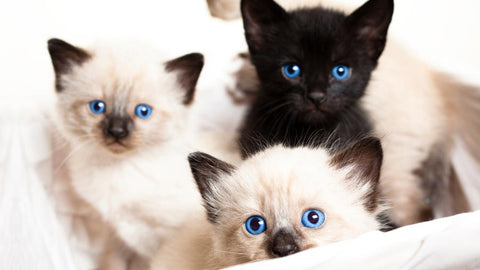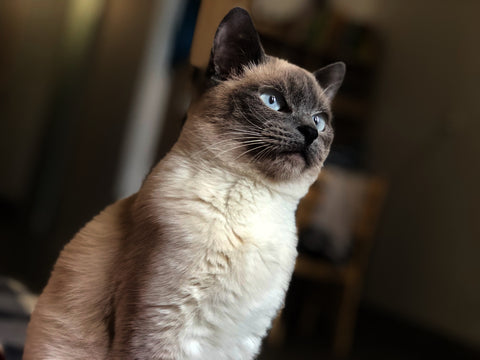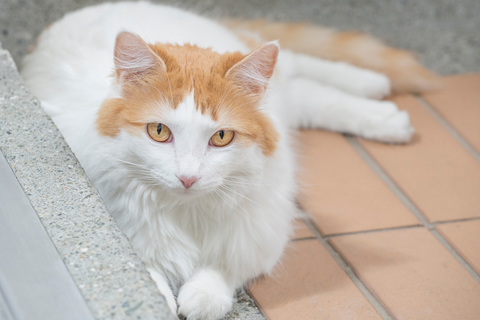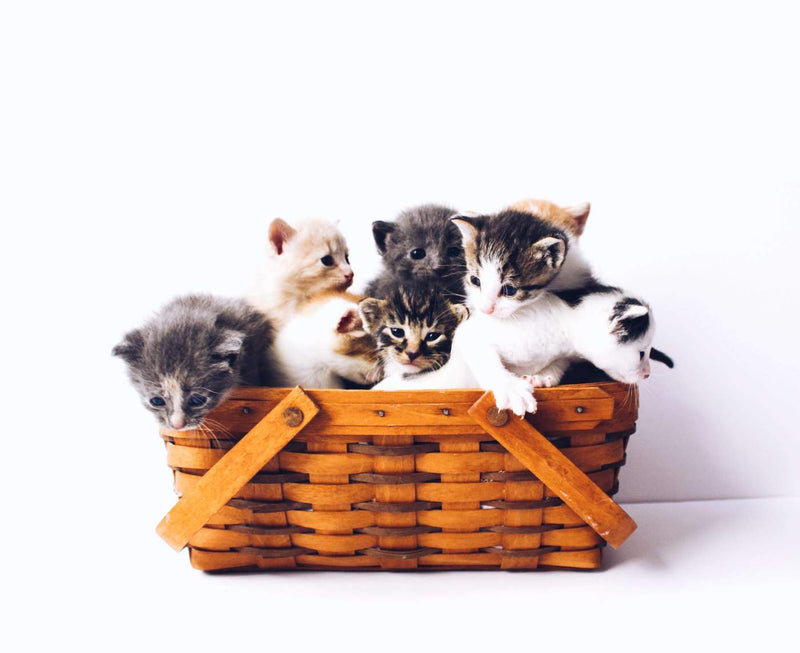
Cat Fur Patterns
There are six varieties of cat fur patterns. These are Tabby, Solid, Bicolor, Tricolor, Tortoiseshell, and Colorpoint.
These various markings arise from the cat’s genetics, and the results can be stunning. Whether your feline is an ultra-rare blue Chartreux or a garden variety Tabby, all cats are gorgeous and hold a special place in our hearts.
1. Tabby
Tabby is the most common pattern for cats' coats. There are four main varieties of Tabby patterning, including Mackerel, Blotched, Spotted, and Ticked.
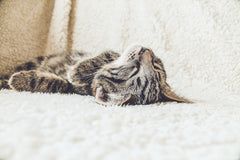
Mackerel tabbies have stripes of dark fur running vertically along with their bodies, with lighter orange or gray coats underneath. These stripes can be uninterrupted or divided up along the stomach and flanks. Mackerel tabbies are also referred to as fishbone tabbies and are the most common type of Tabby-cat.
Blotched tabbies, also referred to as classic or marbled, have a combination of imperfections, swirls, and stripes all over their bodies.
Spotted tabbies, as the name suggests, have spots of different colors over their fur. The number, size, and spacing of these spots vary, with popular Spotted tabby breeds including Maine Coon and Bengal.
Ticked tabbies have a gradient of color in each fur follicle, with a lighter shade at the base and a darker color at the tip. Somali and Abyssinian breeds show this type of fur pattern.
2. Solid
From snow white Turkish Angora to stone grey British Shorthair, cats with Solid color fur patterning capture our attention. To be classified as a Solid colored cat, there can only be one color present on the cat’s body. Because of this, Solid colored cats are not particularly common.
3. Bicolor
Bicolor cats show a fur coloration of white and one other color. This fur pattern is typical amongst mix-breed cats. Why not test your cat’s DNA to see what mix of breeds they are?
There are many different pattern combinations seen in bicolored cats. Frequently visited color combinations are red and white and white and brown. Cats with a Van coat are primarily white, with areas of colored fur on their heads and tails. Black cats with white paws, faces, and bellies are called tuxedo cats (cute!).
4. Tricolor and Tortoiseshell
Tortoiseshell cats are characterized by a mixture of black and red (orange) fur. They can also be found with the ‘diluted’ colors cream and blue.
Tricolor (calico) cats also contain black and red (or cream and blue) but speckle in some white across their coats for good measure.
Most Tortoiseshell and Tricolor cats are female. This is because the genes that code for the black and red fur colors are found on the X chromosome. As males only have one X chromosome, they typically will only be able to display either red or black fur color. In fact, if you do come across a rare male Tortoiseshell or Tricolor cat, the likelihood is he’s sterile (so no point trying to fix him up as a stud!).
5. Colorpoint
Colorpoints are gorgeous cats identified through the dark coloration on their faces, paws, and tails, contrasting the rest of their lighter-colored bodies. These types of markings are most commonly associated with Siamese cats but can also be seen in breeds such as Ragdoll and Himalayan.
Colorpoint is one of the rarest color patterns in cats and has developed due to a genetic mutation that leads to temperature-sensitive albinism. This genetic mutation also leads Colorpoint cats to have their characteristic blue eyes.
Types of Cat Fur
From bald Sphynx to cats with a curly coat, cat fur can vary in length, texture, and abundance.
1. Long-Haired cats
Cats with long fur are majestic, with long flowing manes that link them to their Lion cousins. The colors and patterns vary greatly, and fur can grow up to 5 inches, depending on the breed. Long-Haired cats require frequent grooming to ensure their coats stay luscious and knot-free.

2. Short-Haired Cats
The most common type of cat, short-haired cats, do not grow fur longer than 1.5 inches. Because of this, they are relatively low maintenance, with minimal grooming required and a lower chance of furballs than long-haired felines.

3. Curly-Haired Cats
A genetic mutation causes curly fur. This mutation is recessive, meaning it’s only found in a few cat species, including LaPerm and Devon Rex. Curly-Haired cats can have long or short hair, which can range from a loose curl to a full-on perm!

4. Hairless Cats
We’ve spent a lot of time in this article talking about cat fur patterns, colors, and lengths, but let’s not forget about our bald friends, the hairless cats. Whether you think they’re adorable or that they look like a naked mole-rat, hairless cats certainly make a statement!

A common breed that comes to mind when you think about hairless cats is, of course, the Sphynx, but they are not alone in ditching the fur. There are over ten breeds of entirely bald cats, including Donskoy, Bambino, and Dwelf.
Does the idea of no fur shedding onto your furniture appeal to you? Are you considering getting yourself a hairless cat? Cool! But before you do, make sure you do some research.
The lack of fur can make these kitties more prone to skin conditions such as skin cancer and urticaria pigmentosa, which causes crusty sores on their body. Also, due to the lack of fur, hairless cats can get extra chilly in the winter months, so make sure you keep your home at a comfortable temperature or invest in some kitty knitwear.


